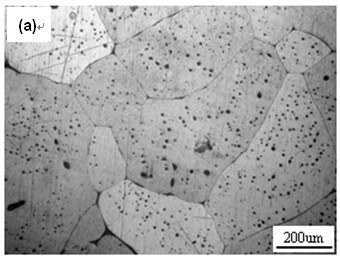Method for thinning Mg-RE-Mn-Sc series magnesium alloy crystalline grains by adding Zr
A mg-re-mn-sc, magnesium alloy technology, applied in the field of metal materials and metallurgy, can solve problems such as unseen and no obvious grain refinement
- Summary
- Abstract
- Description
- Claims
- Application Information
AI Technical Summary
Problems solved by technology
Method used
Image
Examples
Embodiment 1
[0011] Example 1: Under the protection of flux, the Mg-3Ce-1.2Mn-0.9Sc magnesium alloy is melted according to the composition ratio of 94.3wt.%Mg, 3wt.%Ce, 1.2wt.%Mn and 0.9wt.%Sc Raise the temperature to 740°C, add Mg-31wt.%Zr master alloy, and the amount of Zr added is 0.6wt.% of the total weight of the charge. Addition method: Bake the Mg-31wt.%Zr master alloy at 150°C for 20 minutes, then use a pressure ladle to quickly press it below the alloy liquid level for about 3 minutes, heat up to 740°C after stirring, and then use C 2 Cl 6 Refining agent refining treatment for 5 minutes. After refining, stir the alloy melt and let it stand at 740°C for 10 minutes. After standing, remove the surface scum, and then cast it into a metal mold that has been preheated to 100-150°C .
Embodiment 2
[0012] Example 2: Under the protection of flux, the Mg-4Y-1.2Mn-0.9Sc magnesium alloy is melted according to the composition ratio of 93wt.%Mg, 4wt.%Y, 1.2wt.%Mn and 0.9wt.%Sc Raise the temperature to 720°C, and add Mg-31wt.%Zr master alloy. The added amount of Zr is 0.9wt.% of the total weight of charge. Adding method: Bake the Mg-31%Zr master alloy at 150°C for 20 minutes, then use a pressure ladle to quickly press it below the alloy liquid level for about 3 minutes, heat up to 740°C after stirring, and then use C 2 Cl 6 Refining agent refining treatment for 5 minutes. After refining, stir the alloy melt and let it stand at 740°C for 10 minutes. After standing, remove the surface scum, and then cast it into a metal mold that has been preheated to 100-150°C .
Embodiment 3
[0013] Example 3: In CO 2 Under the protection of gas, the Mg-5Gd-1.2Mn-0.4Sc magnesium alloy was melted according to the composition ratio of 93.25wt.%Mg, 5wt.%Gd, 1.2wt.%Mn and 0.4wt.%Sc and then heated to 740°C. Add Mg-31%Zr master alloy. The added amount of Zr is 1.2wt.% of the total weight of charge. Addition method: Bake the Mg-31wt.%Zr master alloy at 150°C for 20 minutes, then use a pressure ladle to quickly press it below the alloy liquid level for about 3 minutes, heat up to 740°C after stirring, and then use C 2 Cl 6 Refining agent refining treatment for 5 minutes. After refining, stir the alloy melt and let it stand at 740°C for 10 minutes. After standing, remove the surface scum, and then cast it into a metal mold that has been preheated to 100-150°C .
[0014] Table 1 shows the composition and structure analysis and performance test results of the above three examples and the Mg-RE-Mn-Sc magnesium alloy without adding Zr. From the comparative analysis result...
PUM
 Login to View More
Login to View More Abstract
Description
Claims
Application Information
 Login to View More
Login to View More - R&D
- Intellectual Property
- Life Sciences
- Materials
- Tech Scout
- Unparalleled Data Quality
- Higher Quality Content
- 60% Fewer Hallucinations
Browse by: Latest US Patents, China's latest patents, Technical Efficacy Thesaurus, Application Domain, Technology Topic, Popular Technical Reports.
© 2025 PatSnap. All rights reserved.Legal|Privacy policy|Modern Slavery Act Transparency Statement|Sitemap|About US| Contact US: help@patsnap.com



